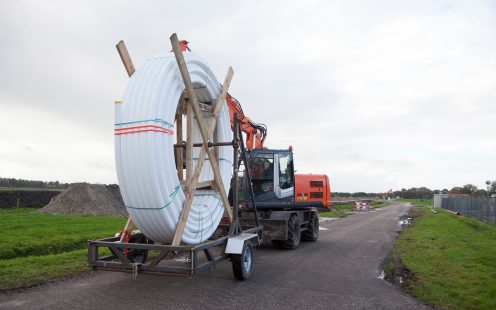.jpg)
Hydrogen Infrastructure for Renewable Energy: Challenges and Solutions
Feb 17th, 2022 | 5 min read
Hydrogen is considered crucial in transitioning towards a carbon-neutral economy by the EU. While production of renewable hydrogen currently is expensive, the cost is expected to decrease in the future due to more efficient technologies and higher availability of alternative power sources. Reinforced thermoplastic piping systems were developed by Pipelife's brand SoluForce with the aim to overcome the challenges of building sustainable high-pressure hydrogen infrastructure.
Blue vs. Green Hydrogen Production
Hydrogen energy is often referred to as "future fuel" as it is completely carbon- and pollution-free. Still, producing hydrogen from natural gas currently is the cheapest and most applied technology, contributing to greenhouse gas emissions. The product is commonly referred to as grey hydrogen; the greenhouse gases released in the process are not captured and enter the atmosphere.
Many governments, however, seeking to expand the use of hydrogen in their energy systems, see potential in hydrogen production from natural gas, if the resulting CO2 is captured and stored underground. This product is often called blue hydrogen or low-carbon hydrogen.
Nevertheless, the European Union is taking a step further and considers blue hydrogen only a temporary solution while transitioning towards hydrogen produced from renewable power sources via water electrolysis. With this production method, electricity is used to split water into hydrogen and oxygen, releasing no greenhouse gases in the process.
The product — green hydrogen — plays a crucial part in the EU's strategy to achieve climate neutrality by 2050 under the ambitious targets of the European Green Deal.
.jpg)
Hydrogen Electrolysis: A Source of Clean Energy
With the capacity of Europe's renewable energy sources rising, more surplus grid electricity becomes available, and it can be used for producing green hydrogen in a cost-efficient way. According to the International Energy Agency (IEA), more than 40% of the current global electrolyzer capacity is based in Europe, and funds are allocated to build more electrolysis plants in the near future.
Electrolysis plants are often deployed in combination with offshore wind farms. Offshore wind speeds tend to be higher and steadier than on land, which means more efficient and reliable energy production. For instance, hydrogen production facilities are currently built next to wind farms in the North Sea and will contribute to supplying clean energy to the Netherlands and Belgium.
Potential of Hydrogen Storage
Energy storage is a potential use of hydrogen that has been under the scrutiny of governments and investors. Renewable energy, such as from wind or solar farms, offers an alternative to fossil fuels; however, the availability of these renewables is weather-dependent. This means that periods of surplus energy alternate with periods of energy shortages, making it challenging to further increase the share of renewables in electricity grids.
Hydrogen storage is a promising solution to the issue. Instead of letting surplus energy created during peak production go to waste, it could be used to produce hydrogen, which can be stored for extended periods in gas or liquid form. The first large-scale hydrogen energy storage systems are already in operation, such as the Energiepark Mainz in Germany.
It is also possible to use hydrogen to increase the share of renewables by introducing hydrogen to gas grids. Without modifications of the EU’s gas grids and appliances, it would be possible to introduce a 5-10% hydrogen blend.
.jpg)
Developing Hydrogen Infrastructure
As promising as a hydrogen-fueled future looks, there are still significant obstacles to overcome. Large-scale adoption of hydrogen into our energy systems calls for safe and cost-efficient infrastructure for its storage and transport. As pointed out by the IEA, "high initial capital costs and associated investment risks can therefore impede hydrogen pipeline system development significantly."
Historically, steel pipes have been used for high-pressure hydrogen transportation; however, their heaviness and inflexible structure results in high installation costs and poor adaptability. In addition, prolonged exposure to hydrogen causes steel pipes to corrode and become vulnerable to stress — the process known as hydrogen embrittlement.

Making Hydrogen Transportation Feasible
Pipelife’s brand SoluForce has developed an innovative piping technology — Reinforced Thermoplastic Pipe (RTP) — that could be the key to resolving the challenges of expanding high-pressure green hydrogen infrastructure. Due to being non-metallic, SoluForce pipes do not suffer from embrittlement or corrosion, which results in prolonged service life and higher safety.
Compared to steel pipes, RTP installation costs are estimated to be at least 70% lower due to lower weight and availability in longer lengths. Furthermore, the production, transportation, installation, re-use and decommissioning of RTP require less energy, reducing the carbon footprint by at least 75% in comparison with steel pipe alternatives.
RTP have been certified for high-pressure hydrogen applications by KIWA. The innovative piping system is already used in hydrogen-transportation projects, such as a large-scale wind park currently under construction in Groningen, the Netherlands — serving as a proof that the complex obstacles around high-pressure green hydrogen transportation can be overcome.
Get in Touch
Please choose your preferred way to get in contact with us. We will get back to you as soon as possible.
Callback